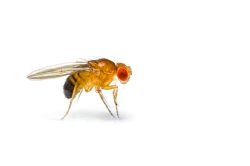Fruit Fly
 Description:
Description:
Fruit flies are small flies. The key identifying characteristic of the fruit fly is its eyes, which are red in color. The head and thorax are tan in color with the abdomen somewhat darker. The two most visible signs of fruit fly activity would be the adult flies and the pupae. Adult flies often are seen flying around in kitchens or trash cans near the decaying fruit or vegetables.
Appearance:
Adults are 3 to 4 mm long, may have red eyes, though some are dark eyed, and a tan thorax. The abdomen is black on top, gray underneath. Fruit flies can appear to be brown or tan in color.
Lifecycle:
Fruit flies develop by complete metamorphosis. The eggs (which are difficult to see with the naked eye) are deposited near the surface of fermenting fruit or organic matters, a pair of filaments that are attached to the eggs protrude above the surface of the liquid. The female fruit fly will lay about 500 eggs. The larvae emerge about 30 hours after the eggs have been laid and feed near the surface of the fermenting material. The larvae feed for five to six days then crawl to drier areas of the food source or even out of the food source to pupate. The larva transforms into the pupa in the last larval skin, or puparium, which bears a conspicuous pair of filaments on the anterior end. The adult fruit fly emerges several days later. The newly emerged fruit flies are attracted to light and become sexually active in about two days. The adults mate more than once. Under ideal conditions, the life cycle from egg to adult can be completed in as little as eight days. The sudden appearance of large populations is not uncommon inside buildings.
Habits:
Fruit flies are especially attracted to ripened fruits and vegetables in the kitchen. But they also will breed in drains, garbage disposals, empty bottles and cans, trash containers, mops and cleaning rags. All that is needed for development is a moist film of fermenting material. Infestations can originate from over-ripened fruits or vegetables that were previously infested and brought into the home. The adults can also fly in from outside through inadequately screened windows and doors.